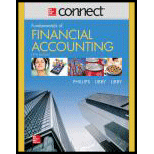
Connect 1 Semester Access Card for Fundamentals of Financial Accounting
5th Edition
ISBN: 9781259128547
Author: Fred Phillips Associate Professor, Robert Libby, Patricia Libby
Publisher: McGraw-Hill Education
expand_more
expand_more
format_list_bulleted
Question
Chapter AC, Problem AC.1PA
To determine
The option to be chosen and the reason for taking the decision.
Expert Solution & Answer
Want to see the full answer?
Check out a sample textbook solution
Students have asked these similar questions
Choose correct option with correct explanation. please avoid if you dont know. DOWNVOTE.
Determine the overhead allocation rate
When should accountants apply cross-sequential analysis methods? (a) Multiple time periods require simultaneous comparison (b) Single period analysis works better (c) Sequential reviews provide more accuracy (d) Time periods remain isolated MCQ
Chapter AC Solutions
Connect 1 Semester Access Card for Fundamentals of Financial Accounting
Ch. AC - Prob. 1QCh. AC - Prob. 2QCh. AC - Which of the following is most likely to be an...Ch. AC - Prob. 4QCh. AC - Prob. 5QCh. AC - Prob. 6QCh. AC - Prob. 7QCh. AC - You are saving up for a Mercedes-Benz SLR McLaren,...Ch. AC - Prob. 2MCCh. AC - Prob. 3MC
Ch. AC - Prob. 4MCCh. AC - Prob. 5MCCh. AC - Assume you bought a car using a loan that requires...Ch. AC - Assume you bought a car using a loan that requires...Ch. AC - Which of the following statements is true? a. When...Ch. AC - Prob. 9MCCh. AC - Prob. 10MCCh. AC - Prob. AC.1MECh. AC - Prob. AC.2MECh. AC - Prob. AC.3MECh. AC - Prob. AC.4MECh. AC - Prob. AC.5MECh. AC - Prob. AC.6MECh. AC - Prob. AC.7MECh. AC - Prob. AC.8MECh. AC - Prob. AC.9MECh. AC - Prob. AC.10MECh. AC - Prob. AC.11MECh. AC - Prob. AC.12MECh. AC - Prob. AC.1ECh. AC - Prob. AC.2ECh. AC - Prob. AC.3ECh. AC - Prob. AC.4ECh. AC - Prob. AC.5ECh. AC - Computing Bond Issue Proceeds and Issue Price Your...Ch. AC - Computing Missing Present or Future Values...Ch. AC - Comparing Options Using Present Value Concepts...Ch. AC - Prob. AC.2CPCh. AC - Prob. AC.3CPCh. AC - Prob. AC.4CPCh. AC - Prob. AC.1PACh. AC - Recording Equipment Purchase with Two-Year Note...Ch. AC - Prob. AC.3PACh. AC - Prob. AC.4PACh. AC - Prob. AC.1PBCh. AC - Recording Equipment Purchase with Two-Year Note...Ch. AC - Prob. AC.3PBCh. AC - Prob. AC.4PB
Knowledge Booster
Learn more about
Need a deep-dive on the concept behind this application? Look no further. Learn more about this topic, accounting and related others by exploring similar questions and additional content below.Similar questions
- Edison Ventures reported its financial results for the year ended December 31, 2023. The company generated $450,000 in sales revenue, while the cost of goods sold amounted to $210,000. The company also incurred operating expenses of $105,000 and reported a net income of $135,000. Additionally, the company's net cash provided by operating activities was $160,000. Based on this information, what was Edison Ventures' profit margin ratio? Right answerarrow_forwardWhich circumstances prompt modified attribution analysis? a) Attribution never needs modification b) Standard attribution works universally c) Complex ownership structures require specialized allocation methods d) Ownership always follows simple patterns Need answerarrow_forwardCadillac Industries estimates direct labor costs and manufacturing overhead costs for the upcoming year to be $920,000 and $725,000, respectively. Cadillac allocates overhead costs based on machine hours. The estimated total labor hours and machine hours for the coming year are 21,000 hours and 8,500 hours, respectively. What is the predetermined overhead allocation rate? (Round your answer to the nearest cent.)arrow_forward
- Solve this Accounting questionarrow_forwardPlease explain the solution to this general accounting problem with accurate principles.arrow_forwardSteel Manufacturing uses a job order costing system. During one month, Steel purchased $188,000 of raw materials on credit; issued materials to the production of $215,000 of which $10,000 were indirect. Steel incurred a factory payroll of $159,000, of which $20,000 was indirect labor. Steel uses a predetermined overhead rate of 150% of direct labor cost. The total manufacturing costs added during the period are___.arrow_forward
arrow_back_ios
SEE MORE QUESTIONS
arrow_forward_ios
Recommended textbooks for you

5 Steps to Setting Achievable Financial Goals | Brian Tracy; Author: Brian Tracy;https://www.youtube.com/watch?v=aXDuLxEJqBo;License: Standard Youtube License